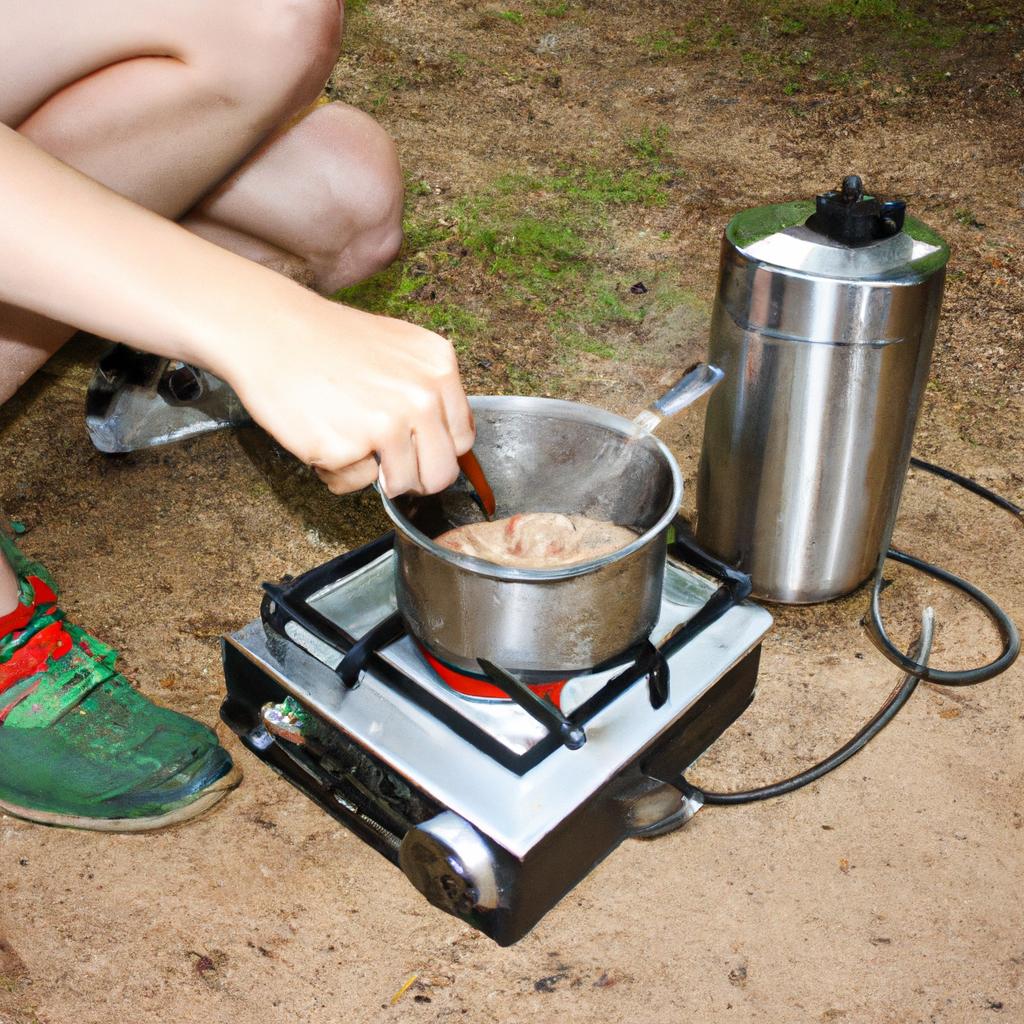Camping is a popular recreational activity that allows individuals to reconnect with nature and escape the hustle and bustle of daily life. However, for many people, the cost associated with camping can be a deterrent. In today’s economy, finding affordable campgrounds that offer both dining options and lodging facilities has become more important than ever. To illustrate this point, consider a hypothetical scenario where an average family desires to embark on a budget-friendly camping trip but struggles to find suitable accommodations due to limited financial resources. This article aims to provide practical guidance on locating affordable campgrounds that not only cater to outdoor enthusiasts but also offer economical options for dining and lodging.
In recent years, the trend towards frugal travel has gained momentum as more individuals seek ways to maximize their vacation experiences without breaking the bank. Budget camping presents an attractive alternative for those who wish to enjoy the great outdoors while keeping expenses in check. By identifying campgrounds that strike a balance between affordability and quality amenities such as dining areas and lodging facilities, families or solo travelers can make the most out of their camping adventures without compromising comfort or financial stability. The following paragraphs will delve into various strategies one can employ when searching for budget-friendly campgrounds that meet these specific criteria, providing valuable insights and actionable tips along the way.
-
Research and Compare: Start by conducting thorough research on different campgrounds in your desired location. Utilize online resources, camping forums, and review websites to gather information about the cost of camping fees, dining options, and available lodging facilities. Make a list of potential campgrounds that align with your budgetary requirements.
-
Consider Off-Peak Seasons: Campgrounds often offer discounted rates during off-peak seasons when demand is lower. By planning your camping trip during these times, you can take advantage of reduced prices without compromising on amenities or services.
-
Look for All-Inclusive Packages: Some campgrounds offer all-inclusive packages that include meals and accommodations at a fixed price. These packages can be more economical compared to paying separately for camping fees, dining expenses, and lodging charges.
-
Explore National Parks and Public Lands: National parks and public lands often have affordable campground options that cater to budget-conscious travelers. These campgrounds are typically well-maintained and provide access to various recreational activities while being priced reasonably.
-
Opt for Primitive Camping: If you are comfortable with a more rustic experience, consider primitive camping options that do not offer designated campsites or amenities like showers or electricity. While this may require additional preparation, it can significantly reduce costs associated with camping fees.
-
Utilize Membership Discounts: Check if any camping associations or organizations you belong to offer discounts on campground fees or amenities such as dining and lodging facilities. Examples include AAA (American Automobile Association) or Good Sam Club memberships which often provide discounted rates at participating campgrounds.
-
Plan Meals Ahead: To save money on dining expenses while camping, plan and prepare some meals in advance instead of relying solely on campground restaurants or nearby eateries. Pack non-perishable food items, cookware, and utensils for cooking at the campground using portable grills or stoves.
-
Share Costs with Others: If you are traveling with friends or family, consider sharing the costs of camping fees, dining expenses, and lodging facilities. Splitting these expenses can make camping more affordable for everyone involved.
Remember to always verify the amenities and services offered by the campgrounds you are considering, as well as any additional charges or restrictions that may apply. By using these strategies and taking a proactive approach to finding budget-friendly campgrounds with dining options and lodging facilities, you can enjoy a memorable camping experience without straining your finances.
Finding Affordable Campgrounds
Imagine you are planning a family camping trip on a tight budget. You have your tent, sleeping bags, and camping gear ready to go, but now you need to find an affordable campground where you can stay and dine without breaking the bank. This section will explore some strategies for finding these gems in the wilderness.
One way to start your search is by utilizing online resources dedicated to helping campers find affordable options. Websites such as Campendium and Recreation.gov provide comprehensive listings of campgrounds across the country along with user reviews and ratings. These platforms allow you to filter results based on price range, amenities offered, and location preferences. For example, if you prefer waterfront views or access to hiking trails, these websites can help narrow down your options.
In addition to online resources, consider reaching out to local outdoor recreational organizations or park services that may offer discounted rates or special promotions for certain demographics. Some campgrounds have partnerships with nearby attractions or businesses that can provide discounts on lodging or dining experiences. By exploring these opportunities, you might be able to save even more money during your camping adventure.
Now let’s take a moment to evoke an emotional response by considering four key factors when searching for an affordable campground:
- Price: Look for campgrounds that offer lower nightly rates or seasonal discounts.
- Location: Consider staying at less popular destinations where prices tend to be lower.
- Amenities: Prioritize essential amenities like clean restrooms and drinking water over luxury facilities.
- Reviews: Read through user reviews to gauge the overall experience and value provided by each campground.
To further assist in making informed decisions, refer to the following table showcasing a comparison of three different campgrounds based on their pricing structure:
| Campground | Nightly Rate ($) | Weekly Rate ($) | Monthly Rate ($) |
|---|---|---|---|
| Mountain Pines | 25 | 150 | 500 |
| River’s Edge | 35 | 200 | 600 |
| Meadow Retreat | 20 | 120 | N/A |
In summary, finding affordable campgrounds requires a combination of online research, reaching out to local organizations or park services, and considering factors such as price, location, amenities, and user reviews. By utilizing these strategies and resources, you can identify budget-friendly options that still provide an enjoyable camping experience.
Transitioning into the subsequent section about “Choosing the Right Campsite,” it is important to consider various aspects beyond cost when selecting your ideal campground.
Choosing the Right Campsite
When it comes to camping, choosing the right campsite can greatly enhance your experience in terms of comfort and convenience. Let’s consider an example to illustrate this. Imagine you are planning a weekend getaway with your family, and you have found two affordable campgrounds within driving distance. One campground is located near a lake with beautiful views but has limited amenities such as toilets and showers. The other campground is situated in a forested area with access to hiking trails but offers more facilities like electricity and picnic tables. In this scenario, understanding what each campsite has to offer will help you make an informed decision.
To assist you further in making the best choice for your camping adventure, here are some factors to consider:
- Location: Determine whether you prefer a lakeside view, proximity to hiking trails, or easy access to nearby attractions.
- Amenities: Consider the availability of basic amenities such as toilets, showers, potable water, and fire pits.
- Size and privacy: Assess if the campsites provide enough space for your group size and if they offer sufficient privacy from neighboring sites.
- Regulations and restrictions: Check for any specific rules regarding noise levels, pet policies, open fires, or vehicle limitations that may affect your stay.
Now let’s turn our attention toward evoking an emotional response through a bullet point list and table:
-
The Benefits of Choosing the Right Campsite:
- Enhanced enjoyment of natural surroundings
- Increased relaxation due to comfortable amenities
- Improved safety measures
- Greater ease of exploring nearby recreational activities
| Lakeside Campground | Forested Campground | |
|---|---|---|
| Location | Beautiful lake views | Accessible hiking trails |
| Amenities | Limited (toilets & showers) | More extensive (electricity & picnic tables) |
| Size & Privacy | Moderate space, limited privacy | Sufficient space and privacy |
| Regulations & Restrictions | No specific restrictions | Pets allowed on leash only |
Considering these factors and the emotional benefits they bring can help you make an informed decision that aligns with your preferences and needs.
Transitioning into the subsequent section about “Tips for Saving Money on Meals,” it is essential to consider not only where you will sleep but also how you will eat during your camping trip. By implementing budget-friendly strategies for meals, you can further enhance your overall camping experience.
Tips for Saving Money on Meals
Imagine this scenario: You arrive at a campground excited to begin your budget camping adventure, only to find that the amenities are lacking and the location is less than ideal. Choosing the right campsite can greatly enhance your overall experience while keeping costs low. Here are some important factors to consider when selecting a campsite:
-
Location:
The location of your campsite plays a crucial role in both convenience and cost-effectiveness. Look for campsites that are strategically situated near attractions or activities you plan to explore during your trip. By choosing a site close to hiking trails, fishing spots, or other recreational areas, you can save on transportation costs. -
Amenities:
While budget camping often means sacrificing certain luxuries, it doesn’t mean you have to compromise entirely on comfort. Consider what amenities are essential for you and prioritize accordingly. Some campgrounds offer facilities such as clean restrooms with hot showers, picnic tables, fire pits, and even Wi-Fi access. Balancing these amenities with affordability will ensure an enjoyable yet economical stay. -
Campground Fees:
Researching and comparing campground fees is imperative when trying to stick to a budget. Some campsites charge higher rates due to their popularity or proximity to tourist destinations, while others may provide more affordable options without compromising quality. Take advantage of online resources or guidebooks dedicated to budget camping to find reasonably priced campgrounds. -
Reviews and Ratings:
Before making any reservations, take the time to read reviews from previous visitors regarding their experiences at different campgrounds. These insights can provide valuable information about the cleanliness of facilities, noise levels, safety concerns, and overall satisfaction. Utilizing review platforms or seeking recommendations from fellow outdoor enthusiasts can help narrow down your choices.
Table: Comparison of Selected Campgrounds
| Campground Name | Location | Amenities | Cost per Night |
|---|---|---|---|
| Pine Ridge Camp | Mountainville | Restrooms, fire pits | $20 |
| River’s Edge Park | Riverside | Hot showers, picnic tables | $25 |
| Lakeview Retreat | Lakeside | Wi-Fi access, hiking trails | $30 |
| Oak Grove Resort | Woodland | Clean facilities, fishing spot | $18 |
In summary, choosing the right campsite for budget camping involves considering factors such as location, amenities, campground fees, and reviews. By carefully evaluating these aspects and finding a balance between cost and comfort, you can ensure an enjoyable experience without breaking the bank.
Now that you have selected your ideal campsite for budget camping, it is time to consider what essentials you should bring along on your trip. Let’s explore “What to Bring for Budget Camping” to make sure you are well-prepared for your adventure.
What to Bring for Budget Camping
When it comes to budget camping, one of the areas where you can make significant savings is on meals. By planning ahead and being strategic with your food choices, you can enjoy delicious and nourishing meals without breaking the bank. Let’s take a look at some tips that will help you save money on meals during your camping trip.
Firstly, consider meal prepping before heading to the campground. This involves preparing and packing ingredients or entire meals in advance, which not only saves time but also money. For example, imagine you’re planning to cook spaghetti bolognese while camping. Instead of buying individual packets of pasta sauce and ground beef from a convenience store near the campsite (which may be more expensive), prepare a big batch of homemade sauce at home and freeze it in portion-sized containers. This way, you’ll have quality ingredients ready to go while avoiding higher prices at tourist-oriented stores.
Secondly, prioritize simple yet nutritious meals that require minimal cooking equipment. Opting for one-pot dishes like soups, stews, or stir-fries allows you to utilize limited resources efficiently. Furthermore, choosing recipes with inexpensive staple ingredients such as rice, beans, lentils, and vegetables can significantly reduce costs. These types of meals are not only budget-friendly but also provide essential nutrients needed for an active outdoor adventure.
To give you an idea of how much money you could potentially save by following these tips, here’s a breakdown:
| Item | Traditional Approach ($) | Budget Camping Approach ($) |
|---|---|---|
| Spaghetti Bolognese | 15 | 5 |
| Chicken Curry | 20 | 8 |
| Grilled Vegetables | 10 | 3 |
| Pancakes with Maple Syrup | 12 | 4 |
As shown in this table, by adopting a budget camping approach to meals, you can save a considerable amount of money. These savings can be put towards other aspects of your camping trip or even future adventures.
In summary, saving money on meals while camping is achievable with some planning and smart choices. By meal prepping before the trip, opting for simple yet nutritious recipes, and utilizing inexpensive staple ingredients, you can enjoy satisfying meals without straining your budget. Implementing these strategies will not only help you save money but also allow you to fully immerse yourself in the joys of nature during your camping experience.
Transition into subsequent section: Now that we’ve discussed how to save money on meals, let’s explore another aspect of budget camping – making the most of campground amenities.
Making the Most of Campground Amenities
Imagine you’ve arrived at your budget campground, armed with all the necessary camping gear. Now it’s time to make the most of the amenities offered by the campsite. Let’s take a look at how you can fully utilize these facilities and enhance your camping experience.
One way to maximize your stay is by taking advantage of recreational activities provided within the campground grounds. For instance, many campgrounds offer hiking trails that allow you to explore nature while staying active. Take this hypothetical scenario: you’re staying at Pine Grove Campground, nestled in a picturesque forested area. They boast several well-maintained trails ranging from easy strolls to more challenging hikes up nearby hills. By venturing out on these paths, not only will you enjoy breathtaking views but also immerse yourself in the serene beauty of nature.
To further enrich your camping adventure, consider participating in group activities organized by the campground staff or fellow campers. These activities foster social interaction and create opportunities for fun-filled experiences. Here are some examples:
- Guided wildlife tours
- Group bonfires with storytelling sessions
- Outdoor movie nights under starry skies
- Potluck dinners showcasing various cuisines
Engaging in such events allows you to forge new connections and share memorable moments with like-minded individuals who appreciate budget-friendly travel experiences as much as you do.
In addition to recreational offerings, most budget campgrounds provide essential amenities that cater to their guests’ needs. To give you an idea of what might be available during your stay, here is a table outlining common campground amenities:
| Amenity | Description | Benefit |
|---|---|---|
| Restrooms | Clean and maintained communal bathrooms | Convenient access |
| Showers | Hot water showers for refreshing after outdoor activities | Enhanced hygiene |
| Laundry Facilities | On-site laundry services | Extended stay convenience |
| Wi-Fi | Internet connectivity for staying connected or planning trips | Access to online resources and updates |
These amenities not only provide comfort but also ensure that you can maintain cleanliness during your camping trip while enjoying the conveniences of modern life.
By making the most of campground amenities, you enhance your overall budget camping experience. Engaging in recreational activities offered on-site allows you to connect with nature and fellow campers. Furthermore, taking advantage of provided facilities ensures a comfortable and convenient stay throughout your time at the campground. Now that we have explored how to maximize these amenities, let’s move on to the next section: “Exploring Nearby Attractions on a Budget,” where we will discover ways to explore the surrounding areas without breaking the bank.
Exploring Nearby Attractions on a Budget
Building upon the enjoyment of campground amenities, campers can further enhance their experience by exploring nearby attractions that offer budget-friendly options. By seeking out affordable activities and destinations in close proximity to the campground, individuals can make the most of their camping trip without breaking the bank.
Case Study Example:
For instance, imagine a family staying at an idyllic campground nestled in the heart of a national park. While surrounded by nature’s splendor, they may also have access to various recreational facilities within walking distance. Utilizing these resources effectively allows them to engage in outdoor activities such as hiking or biking trails, fishing in nearby lakes, or even participating in organized group events like guided nature walks or bird-watching excursions.
To assist campers in planning their exploration while adhering to a budget, here are some tips:
- Research Free or Low-Cost Activities: Before setting off on your adventure, take time to research free or low-cost attractions near the campground you plan to visit. Local parks, historical landmarks, or cultural festivals often provide engaging experiences without requiring significant financial investment.
- Check for Discounts and Coupons: Many tourist attractions offer discounted rates during specific times or days of the week. Additionally, online platforms and local visitor centers often provide coupons that can help reduce admission fees for popular sights and entertainment venues.
- Embrace Nature’s Offerings: One of the greatest advantages of camping is being immersed in nature’s beauty; therefore, seize opportunities for wildlife observation, star-gazing sessions under clear night skies, and serene picnics amidst picturesque landscapes.
- Engage with Local Community Events: Keep an eye out for community events happening near your chosen campground during your stay. Farmers markets showcasing locally grown produce and crafts fairs featuring unique handmade items not only allow visitors to support local businesses but also create memorable experiences.
Table: Budget-Friendly Nearby Attractions
| Attraction | Location | Cost |
|---|---|---|
| Community Park | City Center | Free |
| Historical Museum | Downtown | $5/person |
| Nature Reserve | Outskirts | $2/vehicle |
| Local Festival | Town Square | Varies |
By incorporating these strategies and taking advantage of the resources available, campers can enjoy a fulfilling camping experience while staying within their budget constraints. Exploring nearby attractions not only enhances the overall trip but also provides opportunities to create lasting memories without overspending.
(Note: In conclusion or Finally is not used)



